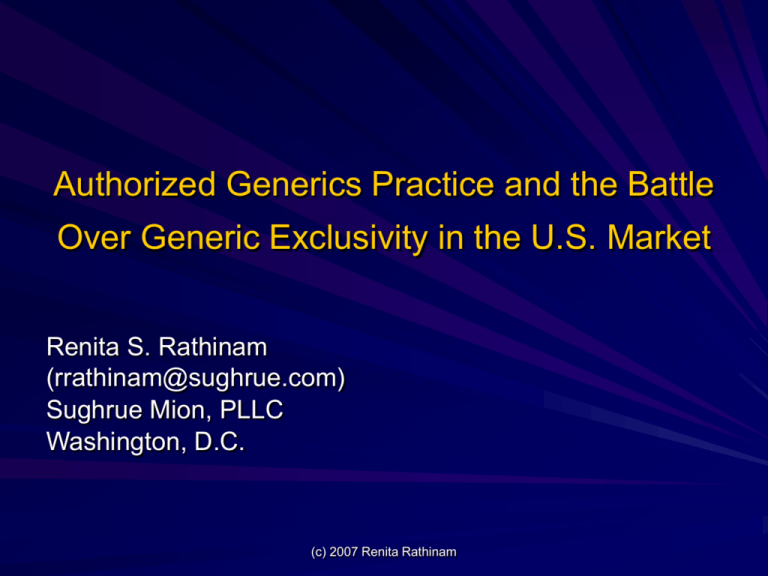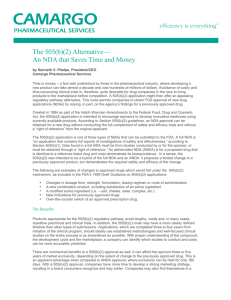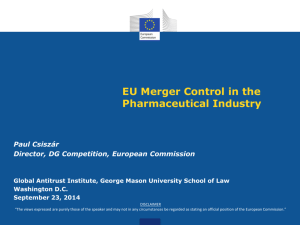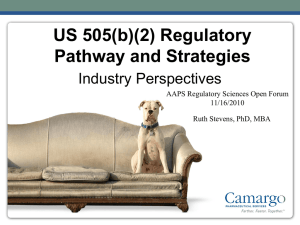Authorized Generics
advertisement

Authorized Generics Practice and the Battle Over Generic Exclusivity in the U.S. Market Renita S. Rathinam (rrathinam@sughrue.com) Sughrue Mion, PLLC Washington, D.C. (c) 2007 Renita Rathinam Lecture Overview Practice Overview Statutory Background Policy Debate FDA Position Challenging the Legality of AG Practice in U.S. courts VI. FTC Involvement VII. Legislation I. II. III. IV. V. (c) 2007 Renita Rathinam Authorized Generics Practice Overview Authorized Generics (AGs) Defined Generally: pharmaceuticals marketed by or on behalf of an innovator drug co., but sold under a generic name *a.k.a- “branded.” “pseudo” or “flanking” generic Typical timing of AG market entry: – end of the NDA holder’s exclusivity period before generic competition or with the introduction of a generic version of the brand name drug (c) 2007 Renita Rathinam Authorized Generics Practice Overview Historical Overview and Current practice Practice can be traced back to the 1990’s -CRS Report for Congress (Aug. 8, 2006) (“CRS Report”) Authorized generics practice did not become prominent until recent years -Id; see also FDA Response, Docket Nos. 2004P-0075 & 2004P-0261, at 6-7 Today, AG practice for extending brand name drug life cycles is significantly more widespread (c) 2007 Renita Rathinam Authorized Generics Practice Overview Bradley Pharmaceuticals- Pamine® (methscopolamine Bromide) "While Pamine ®represented approximately 7% of Bradley Net Sales, during the nine months ended September 30, 2006, we proactively planned for this introduction and are pleased to be in a position to successfully execute our strategy of extending the life cycles of our established brands. The introduction of the Pamine® generic expands the A. Aarons line of generic products offered to the wholesale and chain pharmacy distribution channels. The A. Aarons subsidiary was launched in January of 2006 and its presence in the generic market is beginning to grow both in volume and acceptance. Consistent with other products that have experienced generic competition in our portfolio, we will continue to manufacture and distribute branded Pamine®." Statement by Bradley Pharmaceuticals Chairman, President and CEO, Daniel Glassman (January 2007), emphasis added (c) 2007 Renita Rathinam Authorized Generics Practice Overview Examples of AG Arrangements Proctor & Gamble –generic Macrobid ®: – Mylan Pharmaceuticals reportedly lost tens of millions in generic sales when NDA holder Proctor & Gamble licensed a third party to sell an authorized generic version of Macrobid (nitrofurantoin) during Mylan’s exclusivity period. – Mylan Pharm. Inc. v. FDA, 454 F.3d 270 (4th Cir. 2006) (c) 2007 Renita Rathinam Authorized Generics Practice Overview: AG Arrangements cont’d GlaxoSmithKline- Par Pharmaceutical: Generic Paxil ® (paroxetine hydrochloride): Apotex’s expected sales of up to $575 million cut to $150-$200 million See CRS Report for Congress (Aug. 8, 2006) (c) 2007 Renita Rathinam Authorized Generics Practice Overview: AG Arrangements cont’d Merck- Dr. Reddy’s: Generic Zocor® : – Teva Pharmaceuticals Industries Ltd. attributed 9.5% drop in shares to concerns its generic version of Merck & Co. Inc.'s cholesterol drug Zocor. MarketWatch Inc., Dow Jones Online Network (June 21, 2006) (c) 2007 Renita Rathinam Relevant Statutory Background (c) 2007 Renita Rathinam Statutory Background 180-day Exclusivity Under Hatch Waxman 21 U.S.C. 355(j)(5)(B)(iv)- 180-day exclusivity period Effectiveness of application.— Subject to subparagraph (D), if the application contains a certification described in paragraph (2)(A)(vii)(IV) and is for a drug for which a first applicant has submitted an application containing such a certification, the application shall be made effective on the date that is 180 days after the date of the first commercial marketing of the drug (including the commercial marketing of the listed drug) by any first applicant. (c) 2007 Renita Rathinam Statutory Background "increases the economic incentives for a generic company to be the first to file, because the generic applicant has the potential to reap the reward of marketing the only generic product (and, thus, to charge a higher price until more generic products enter [the market])." Federal Trade Commission, To Promote Innovation: The Proper Balance of Competition and Patent Law and Policy, Ch. 3, at 12 (Oct. 2003), – available at http://www.ftc.gov/os/2003/10/innovationrpt.pdf. (c) 2007 Renita Rathinam Statutory Background Exclusivity benefit motivates "generic manufacturers to challenge the validity of listed patents and to 'design around' patents to find alternative, non-infringing forms of patented drugs" so that they can be the first to file paragraph IV ANDAs. -Teva Pharms. USA, Inc. v. Pfizer, Inc., 395 F.3d 1324, 1328 (Fed. Cir. 2005). (c) 2007 Renita Rathinam Statutory Background Competing Policy Goals To expedite arrival of generic drugs to market To induce name-brand pharmaceutical companies to invest in R&D and develop new drug products (c) 2007 Renita Rathinam Policy Debate (c) 2007 Renita Rathinam Policy Debate AG Opponent Views Congressional Intent “core purpose of Hatch Waxman... is to expedite and maximize the introduction of cost-saving generic drugs, while protecting all legitimate patent rights of drug product innovators...but without unintended windfalls to crafty companies” -See Teva Citizen Petition, Docket No. CP004P-0261 (June 9, 2004) (c) 2007 Renita Rathinam Policy Debate: Opponent Views cont’d Exclusivity provisions represent the key mechanism for achieving this goal Congress did not intend for brand-name companies to benefit from the 180 exclusivity provision only qualified ANDA applicants are entitled to market and sell generic versions of a branded product prior to expiration of a 180-day exclusivity period (c) 2007 Renita Rathinam Policy Debate: Opponent Views cont’d AG practice represents a strategy devised to destroy the incentives offered by 180-day exclusivity provisions brand name companies market AGs as if they are ANDA approved generic products, at times pricing them substantially lower than the competing generic version and causing customer confusion Generic firms unable to recoup substantial costs -Generic Drug Entry: Prior to Patent Expiration, An FTC Study (July 2002) (c) 2007 Renita Rathinam Policy Debate: Opponent Views cont’d costs associated with generic drug development are no longer adequately recouped evaluation of relevant IP, R&D, equivalence testing, FDA submissions and certifications, litigation reduction in returns of 180-day exclusivity profits discourage generic companies from filing paragraph IV challenges reduced incentive to incur risk associated with patent challenges (c) 2007 Renita Rathinam Policy Debate: Opponent Views cont’d *intrusion of branded generics during 180-exclusivity destroys Hatch Waxman incentives and threatens the entire existence paragraph IV generic drug approval process. →→→ irreparable harm to first ANDA filers and the public. (c) 2007 Renita Rathinam Policy Debate AG Proponent Views Congressional Intent: a central goal of Hatch Waxman is to promote price competition in prescription drugs upon expiration or resolution of an NDA holder’s patent rights - Comments of Pfizer Inc on Docket No. C1 2004P-0261 (June 23, 2004); See also In re Barr Labs. Inc., 930 F.2d 72, 76 (D.C. Cir.) (c) 2007 Renita Rathinam Policy Debate: Proponent Views cont’d Congress intended that first ANDA filers would receive a limited competitive advantage over subsequent ANDA filers but would be forced to compete with the approved NDA product. - Id.(505(j)(B)(iv) imposes no limitations on NDA holders) Congress intended to encourage generic firms to filed ANDA and challenge existing patents, but did not intend to give FDA authority to regulate competition between ANDA and NDA Holders -Id. (c) 2007 Renita Rathinam Policy Debate: Proponent Views cont’d AGs do not discourage patent challenges An authorized generic is only one of many possible competitors 21 U.S.C. § 355 (j)(5)(B)(iv)(II)(bb) provides for multiple first applicants. First ANDA applicants already choose to bear litigation costs, with no guarantee of monopoly profits during the 180-day period of exclusivity. (c) 2007 Renita Rathinam Policy Debate: Proponent Views cont’d AG Practice promotes competition and consumer welfare AG arrangements promote early introduction of multiple competitively priced products an provide consumers with faster access to lower priced drugs consistent with Congressional intent underlying Hatch Waxman (c) 2007 Renita Rathinam Policy Debate: Proponent Views cont’d absent authorized generics, during 180 day exclusivity periods, generic drugs are typically priced substantially higher than after subsequent generic products enter the market. See FDA Supports Broader Access to Lower Priced Drugs, FDA Talk Paper (July 2, 2004). Opponents seek to insulate generic companies from competition altogether See e.g. Comments of Pfizer Inc on Docket No. C1 2004P-0261 (June 23, 2004) (c) 2007 Renita Rathinam Policy Debate: Proponent Views cont’d AG Practice permits brand-name firms to recoup the costs of drug development and may fuel innovation process of bringing a pioneer drug to market takes about 12 years average associated costs associated with new drug development have been estimated at $802 million “Policy and New Drug Development “ (December 2006) available at http://www.ftc.gov/be/workshops/pharmaceutical/Lutter.pdf (c) 2007 Renita Rathinam Policy Debate: Proponent Views cont’d revenue from authorized generics may support additional pharmaceutical innovation settlements resulting in authorization of an ANDA applicant to produce and AG may allow brand name firms to stabilize risk associated with litigation, also supporting future innovative activity -CRS Report for Congress (Aug. 8, 2006) (c) 2007 Renita Rathinam Citizen Petitions and FDA Positions (c) 2007 Renita Rathinam Citizen Petitions Teva Citizen Petition, Docket No. 2004P-0261 (June 9, 2004) Teva petitioned the FDA to prohibit Pfizer Inc. from marketing a generic version of Accupril (R) until after Teva’s 180-day exclusivity -Pfizer’s launch of its own AG would undermine congressional intent of the 180-day exclusivity provisions -“FDA is authorized, and indeed compelled, by current law, regulations, policy to take the action requested herein.” Ruling: Denied (c) 2007 Renita Rathinam Citizen Petitions Mylan Citizen Petition, Docket No. 2004P-0075 (February 7, 2004) Mylan petitioned the FDA to prohibit marketing and distribution of AGs until the expiration of the 180-exclusivity period. urged that the FDA implement an approval requirement for AGs which would prevent the sale of an authorized generic until the expiration of an ANDA first filer’s exclusivity period (c) 2007 Renita Rathinam Mylan Petition cont’d The FDA has viewed authorized generics as generics and acted in prior rulings to convert an NDA into and ANDA. FDA has ample authority to prohibit marketing of AGs. -All AB-rated generic drugs must be approved by the FDA as bioequivalent to the reference listed drug prior to marketing (21 U.S.C. 355 (j)) -though AGs lack the AB -rating, they are permitted to be marketed in the same manner as an AB-rated generic and marketed as such Ruling: Denied (c) 2007 Renita Rathinam FDA Positions and Current Policy to deny petitions to prohibit the sale of an AG during 180 day exclusivity periods. - FDA Response, Docket Nos. 2004P-0075 & 2004P-0261 (2 July 2004), denying petition by Mylan Pharmaceuticals, Docket No. 2004P0075/CP1, and by Teva Pharmaceuticals, U.S.A., Docket No. 2004P-0261/CP1). AG, as currently defined by the FDA: “[a]ny marketing by an [New Drug Application (NDA)] holder or authorized by an NDA holder, including through a third-party distributor, of the drug product approved under the NDA in a manner equivalent to the marketing practices of ANDA applicants (c) 2007 Renita Rathinam FDA Positions and Current Policy Hatch Waxman gives the FDA authority to delay entry into the market of ANDA generic drugs but not branded generic drugs. – See Teva Pharms Indus. v. FDA, 355 F. Supp. 2d 111, 115 ( D.D.C. 2004) No statutory basis for imposing approval requirements for the marketing of authorized generics as a means to prevent their marketing during 180-day exclusivity. – Id. at 117 (D.D.C. 2004) Marketing of an authorized generic during the 180-day generic exclusivity period is a long-standing procompetitive practice permissible under the statute. – See FDA Response, Docket Nos. 2004P-0075 & 2004P-0261, at 2, 13 (c) 2007 Renita Rathinam FDA Positions and current policy In 2004, Andrx Pharmaceuticals, Inc. petitioned the FDA to reexamine its policy with respect to authorized generics in general and particularly with respect to the marketing of an AG version of Concerta (R) during Andrx’s exclsuivity period, by Patriot Pharmaceuticals, Inc., an affiliate of NDA holder, McNeil Speciality and Consumer Pharmaceuticals. – See Andrx Citizen Petition, Docket No. 2004P-0563 (23 December 2004), available at www.fda.gov/ohrms/dockets/dockets/04p0563/04p-0563-cp0000-01-vol1.pdf Andrx also presented an additional statutory based argument – FDA authority has authority to prevent misbranding under section 502(a) of the FDCA. – labeling and marketing of branded drugs as generic version is fundamentally misleading. (c) 2007 Renita Rathinam FDA Positions and current policy FDA has failed to adequately consider the potential short-term and long-term effects on competition associated with the use of authorized generics to undermine the availability of actual generics Further, FDA has acknowledged lack of expertise with respect to competition and related economic analyses. – Andrx requested that FDA seek comments from FTC and Department of Justice (c) 2007 Renita Rathinam FDA Positions and Current Policy …still waiting for a response from the FDA (c) 2007 Renita Rathinam Challenging the Legality of AGs in U.S. Courts Hatch Waxman provisions exclude generics, authorized or not, from the market during the 180-exclusivity period awarded to first to file ANDA applicants – Literal interpretation cannot defeat the statutory purpose to grant the first ANDA filers complete exclusivity for 180 days Teva Pharmaceutical Industries, Ltd., v Crawford, 410 F.3d 51 (D.C. Cir. 2005) (c) 2007 Renita Rathinam Challenging the Legality of AGs in U.S. Courts cont’d – Court said: “nothing in the statute provides any support for the argument that the FDA can prohibit NDA holders from entering the market with a generic drug during the exclusivity period” Hatch Waxman does not specify the manner in which and NDA holder must market its drug. Pre Hatch-Waxman, the FDCA did not prevent an NDA holder from marketing an authorized generic. – what basis exists for declaring a previously lawful practice unlawful when Congress in passing Hatch Waxman, remained silent with respect to this practice. (c) 2007 Renita Rathinam Challenging the Legality of AGs in U.S. Courts cont’d "brand-generic intrusion [into the exclusivity period] developed only recently as a routine brand-company business strategy . Congress had not anticipated the practice and thus remained silent. literal interpretation of the statute renders the exclusivity granted by Hatch Waxman meaningless against later ANDA filers as opposed to a commercially effective exclusivity against NDA holders as well. Teva Pharmaceutical Industries, Ltd., v Crawford, 410 F.3d 51, 54 (D.C. Cir. 2005) (c) 2007 Renita Rathinam Challenging the Legality of AGs in U.S. Courts cont’d D.C Circuit: – Hatch Waxman may have created incentive to challenge brand-drug patents but the Act does not provide that that incentive is without limitation. – Rather, Congress sought to strike a balance between incentives, on the one hand, for innovation, and on the other, for quickly getting lower-cost generic drugs to market. (c) 2007 Renita Rathinam Challenging the Legality of AGs in U.S. Courts cont’d Striking that balance is matter of legislative judgment. Accordingly, the Court must attend closely to the terms in which the Congress expressed that judgment. the FDA may not revise the specific statutory incentive that Congress enacted or ... alter the means chosen by Congress to implement its purpose by offering a different incentive The statute is unambiguous (c) 2007 Renita Rathinam Challenging the Legality of AGs in U.S. Courts cont’d means that Congress "deemed appropriate, and prescribed" to give generic drug makers an incentive to challenge brand-drug patents is unambiguous: – That is.... The FDA may not approve a second or later ANDA containing a paragraph (IV) certification until 180 days after the first filer with such a certification begins commercially marketing the drug or wins a court decision against the patent holder. There is simply no way to read that limitation upon what the FDA may do in such a way as to prevent the holder of an approved NDA, which does not need to file an ANDA and certainly would not challenge its own patent, from marketing a brand-generic product. (c) 2007 Renita Rathinam Challenging the Legality of AGs in U.S. Courts cont’d Further, reading the Act as it is written does not render "meaningless" the "specific statutory incentive that Congress enacted." – For 180 days the generic market belongs to a first ANDA filer and the NDA holder; absent an agreement of the sort by which Teva itself entered the market for generic gabapentin, no other firm may enter and take any part of either company's market share. (c) 2007 Renita Rathinam Challenging the Legality of AGs in U.S. Courts authorized generics are generic drugs and thus, subject to prohibitions against marketing generic drugs during the exclusivity period awarded to a first ANDA applicant branded generics are legal and functional equivalents of ANDA generics for purposes of applying and enforcing the 180-day exclusivity period under Hatch Waxman – Mylan Pharm. Inc. v. FDA, 454 F.3d 270 (4th Cir. 2006); see also Mylan Pharm. Inc., Citizen Petition 2004P-0075/CP1 (February 4, 2004) citing Mylan v. Thompson, 207 F. Supp. 2d 476 (N.D.W. Va 2001) (c) 2007 Renita Rathinam Challenging the Legality of AGs in U.S. Courts cont’d But are brand generics actually legal and functional equivalents of ANDA generics for purposes of applying and enforcing Hatch Waxman exclusivity provisions? – Mylan Pharm Inc.v. Thompson, 207 F. Supp, 2d 476 (N.D.W. Va 2001) First ANDA filer, Mylan began marketing a brand generic version of Pfizer’s Procardia (nifedipine) pursuant to an agreement with Pfizer. Mylan had not actually sold the product that was subject of its ANDA Mylan asserted that branded generics are not the specific subject of an approved ANDA. Accordingly ANDA generics are legally and functionally distinct in the context of exclusivity under Hatch Waxman (c) 2007 Renita Rathinam Challenging the Legality of AGs in U.S. Courts cont’d Mylan argued: marketing of a branded generic did not constitute “commercial marketing” of a generic drug for purposes of triggering its 180-day exclusivity period. Subsequent ANDA filer, Teva petitioned the FDA to rule that marketing of a branded generic constituted commercial marketing of Mylan’s own ANDA product. The FDA agreed, “permitting Mylan to market nifedipine without triggering the beginning of the exclusivity would be inconsistent with the intent of the statutory scheme.” (c) 2007 Renita Rathinam Challenging the Legality of AGs in U.S. Courts cont’d Fourth Circuit response: “Prior agency interpretation (whether or not it supports Mylan’s reading) is irrelevant because the statute unambiguously forecloses that reading. Mylan v. FDA, 454 F.3d at 276 (4th Cir. 2006) (c) 2007 Renita Rathinam FTC Involvement (c) 2007 Renita Rathinam FTC Involvement “introduction of an authorized generic will likely diminish the incentives for generic firms to challenge patents and incur substantial development and litigation costs.” FTC Commissioner, Jonathan Liebowitz quoted in Chain Drug Review (June 2005) FTC recognition of: – occurrence of authorized generic arrangements in increased frequency; and – absence of comprehensive economic study http://www.ftc.gov/os/2006/03/P062105AuthorizedGenericDrugStudyFRNotice.pdf (c) 2007 Renita Rathinam FTC Involvement cont’d March 29, 2006 FTC announced it Authorized Generic Drug Study: FTC Project P062105 to evaluate short and long term effects of authorized generics practice and clarify competitive impact of AGs Id Comments were due June 5, 2006 Id Report expected at some point during 2007 (c) 2007 Renita Rathinam FTC Involvement Study will include examination of Actual wholesale prices (including rebates and discounts, etc) for brand name and generic drugs, with and without AG competition; Business decisions that support AG entry; Factors relevant to generic firms as to whether to seek entry prior to patent expiry; Licensing agreements for AGs (c) 2007 Renita Rathinam Basis for Antitrust claims? (c) 2007 Renita Rathinam Antitrust claims? If pricing of AGs can be deemed “predatory pricing” and such is found to destroy competition, public policy articulated by the Sherman Antitrust Act may be violated. – See Judge Keeley comments, Mylan Pharm. Inc. v. FDA, Civ. No. 1:04 cv 174(N.D. W. Va.) (filed Aug. 5, 2005; withdrawn without prejudice Aug. 30, 2004) (c) 2007 Renita Rathinam Recent and Pending Legislation (c) 2007 Renita Rathinam Pending Legislation July 24, 2006: Senators Rockefeller, Leahy and Schumer introduced a U.S. Senate bill, S. 3695 to amend the Federal Food, Drug, and Cosmetic Act to prohibit the marketing of authorized generic drugs during an ANDA filer’s 180-day exclusivity period. January 30, 2007: The bill, co-sponsored by Senator Kohl was reintroduced as S. 438, "The Fair Prescription Drug Act." February 5, 2007: Companion bill, H.R. 806 was introduced in the House of Representatives (c) 2007 Renita Rathinam 110th Congress, 1st Session S.438 (Fair Prescription Drug Competition Act) available at http://thomas.loc.gov/cgibin/query/D?c110:2:./temp/~c1 10viu3Ng:: “Section 505 of the Federal Food Drug, and Cosmetic Act (21 U.S.C.) is amended by adding at the end the following: (c) 2007 Renita Rathinam 110th Congress, 1st Session S.438 (Fair Prescription Drug Competition Act cont’d (c) 2007 Renita Rathinam 110th Congress, 1st Session S.438 (Fair Prescription Drug Competition Act cont’d (c) 2007 Renita Rathinam Pending Legislation Opponents expect greater chances of success for the proposed legislation this year. Generics firms, Mylan and Barr have met with lawmakers on Capitol Hill for purposes of educating them on authorized generics practice – http://www.mysanantonio.com/business/stories/MYSA 030407.3R.sungenerics.23d3c33.html FTC Report expect later this year will lend additional support (c) 2007 Renita Rathinam Recent Legislation: S.1932 Deficit Reduction Act of 2005 (DRA) Enacted February 8, 2006, text available at http://www.cbo.gov/ftpdocs/70xx/doc7028/s1932conf.pdf Includes changes in calculation and reporting obligations with respect to pricing data for determination of Unit Rebate amounts (URA) under the Medicare Drug Rebate Statute – URAs for NDAs are largely calculated based on the difference in between Average Manufacturer Price and “best price” to any commercial customer. NDA holders have previously excluded authorized generics from the best price or AMP (c) 2007 Renita Rathinam S.1932 Deficit Reduction Act of 2005 (DRA) cont’d DRA definition of “best price” requires brand manufacturers to include all prices at which it sells its NDA product including prices to AG distributors. – Likely to see increase in URA due to lower “best price” DRA definition of AMP is inclusive of the average paid by wholesalers for drugs distributed for retail, reducing the AMP. (c) 2007 Renita Rathinam S.1932 Deficit Reduction Act of 2005 (DRA) cont’d Some ambiguities, but overall effect of making AG arrangements less desirable for innovator companies. (c) 2007 Renita Rathinam Thank you. (c) 2007 Renita Rathinam






